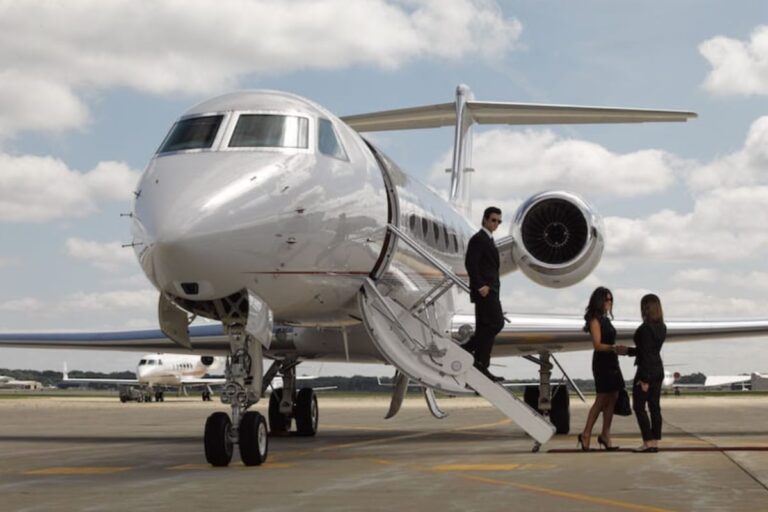You pull up to a private entrance. No long security lines. No crowds pushing past you. Just a quiet lounge with comfortable chairs and someone ready to help you immediately. This isn’t some fantasy.
This is what flying through an FBO looks like. If you’ve heard pilots or private aviation folks mention FBOs and wondered what they’re talking about, you’re about to find out everything you need to know.
What is FBO in Aviation?
Let’s start simple. FBO stands for Fixed-Base Operator. These are private businesses that operate at airports and provide services for aircraft, pilots, and passengers.
Think of them as private terminals for aviation. While commercial passengers use the main terminal with all its chaos, private fliers use FBOs for a completely different experience.
What is FBO in aviation terms? It’s an organization with official airport rights to deliver aeronautical services.
These services cover everything from fueling your plane to providing a comfortable place to wait. What is FBO in flying compared to regular commercial travel? It’s the difference between fighting crowds at a gate and walking straight to your aircraft.
An FBO handles what pilots and aircraft owners need. Fuel. Maintenance. Parking. Flight planning. The list goes on. What is FBO in private aviation specifically? It’s your gateway to the sky without the headaches of commercial terminals.
What is FBO in flight operations? It’s the support system that keeps private and charter aviation running smoothly.

The History Behind the Name
The term “Fixed-Base Operator” sounds oddly specific. There’s a good reason for that. After World War I ended, tons of military surplus aircraft flooded the market. Pilots bought these planes cheap and started barnstorming across America.
They’d land in farmers’ fields, set up temporary operations, and offer rides or flight lessons for cash. This worked fine until the government stepped in. The Air Commerce Act of 1926 changed everything. Suddenly pilots needed licenses.
Aircraft needed maintenance standards. The freewheeling days of landing wherever you wanted were over. Those temporary flying circuses couldn’t operate the same way anymore.
Smart pilots and mechanics adapted. They established permanent businesses at actual airports. They called themselves “fixed-base” operators to separate their legitimate operations from the old barnstorming days.
The name stuck. Nearly 100 years later, we still use the same term. These permanent businesses became essential parts of aviation infrastructure across the United States and eventually worldwide.
What Does an FBO Do at an Airport?
Walk into an FBO and you’ll immediately see the difference from a commercial terminal. The staff knows your name. Your aircraft gets personal attention. Services get customized to what you actually need. But what specific services does an FBO provide?
Aircraft Services
Fuel stands at the core of FBO operations. Your plane needs gas, and FBOs supply it. They stock different fuel types. Jet-A powers turbine engines. AvGas fuels piston engines. Line workers come out and fuel your aircraft quickly so you can get back in the air.
Beyond fuel, FBOs handle aircraft parking and storage. Short-term tie-downs work for quick stops. Long-term hangar space protects your plane from weather. Some FBOs offer heated hangars for winter storage.
Aircraft maintenance and repairs happen right there too. Need an oil change? Engine inspection? Interior cleaning? The FBO either does it themselves or connects you with qualified mechanics.
Ground equipment and support services round out aircraft care. De-icing in winter. Ground power units when you need electrical hookups. Lavatory service for larger aircraft. Towing and positioning. All the technical stuff that keeps aircraft operating safely.
Passenger Services
FBOs treat passengers like VIPs. Private lounges offer comfortable seating, not cramped gate areas. High-speed WiFi lets you work or browse. Complimentary refreshments range from coffee and snacks to full meals at larger facilities. Some FBOs stock gourmet options that beat anything you’d find in a commercial terminal.
The check-in process takes minutes, not hours. You show your ID to a staff member. That’s basically it. No removing shoes. No bag searches. No standing in lines that snake through the terminal. Most passengers arrive just 15-30 minutes before departure.
Concierge services handle whatever you need. Ground transportation? They’ll arrange it. Hotel reservations? Done. Restaurant recommendations? They know the best spots.
International travelers appreciate on-site customs and immigration at many FBOs. It’s still required, but way faster than the commercial terminal process.
Pilot Services
Pilots rely on FBOs just as much as passengers do. Flight planning rooms provide weather briefings and route assistance. Crew lounges offer places to relax between flights. Some pilots spend hours at FBOs waiting for passengers. Comfortable amenities matter.
Can pilots sleep at an FBO? Yes, many FBOs provide rest areas. Larger facilities have dedicated snooze rooms with recliners or beds. Pilots on long trips or overnight flights use these spaces. Charter pilots especially appreciate shower facilities for freshening up. Not every FBO offers sleeping quarters, but plenty do. The bigger the FBO, the more likely they’ll have proper rest facilities.
What is FBO in Aviation Examples
Understanding FBOs becomes easier with real examples. Several major chains operate across the country and internationally.
Signature Flight Support runs over 200 locations worldwide. They’re the biggest FBO network. You’ll find Signature at major airports across the United States and in key international locations. Their facilities tend toward the luxury end with premium amenities.
Atlantic Aviation operates more than 60 locations in the United States. They focus on customer service and competitive fuel pricing. Atlantic facilities range from small regional setups to major metropolitan locations.
Is Jet Aviation an FBO? Yes. Jet Aviation runs FBO operations alongside aircraft management and maintenance services. They operate globally with facilities in Europe, Asia, and the Americas. Their Basel facility in Switzerland is particularly well-regarded.
FBO Airport Code System
FBOs use location-based identification tied to airport codes. When pilots file flight plans or discuss destinations, they reference the airport code. The FBO at that location serves aircraft arriving there. For example, Signature at Van Nuys Airport operates at KVNY. Atlantic Aviation at Teterboro uses KTEB as their location identifier.
Finding FBOs at specific airports is straightforward. Websites like AirNav and ForeFlight list all FBOs at each airport. You can compare services, fuel prices, and fees before you even take off.
How Many FBOs Are There in the World?
The FBO industry is bigger than most people realize. Around 4,500 FBOs operate worldwide. The United States dominates with roughly 3,000 FBOs spread across the country. That’s significantly more than the approximately 500 commercial airports serving airline traffic.
This high number makes sense. Private aviation uses thousands of small and medium airports. Commercial airlines concentrate on major hubs. General aviation spreads across the entire country. Every region needs FBO services to support local pilots, flight schools, and charter operations.
Ownership models vary widely. Some FBOs are independently owned and operated by local families or aviation enthusiasts. Others belong to major chains like Signature or Atlantic. Chain FBOs offer consistency. You know what to expect at any of their locations. Independent FBOs bring local character and often more personalized service. Both types serve important roles in the aviation ecosystem.
FBO Classification Tiers
Not all FBOs are created equal. The industry uses a three-tier classification system based on revenue and services offered.
Tier One FBOs represent the top level. These operations generate over $25 million annually. They provide full-service everything. Comprehensive fuel services for all aircraft types. Large hangar facilities. Complete maintenance and technical services for turbine aircraft.
Many house OEM-certified service centers. They offer aircraft charter and management services too. When you think luxury private aviation, you’re thinking Tier One FBOs.
Tier Two FBOs sit in the middle with $10-25 million in annual revenue. They still offer full fuel services and hangar space. Maintenance capabilities focus on turbine aircraft like Tier One facilities. The difference shows in scale and specialization.
Tier Two FBOs often handle specialized missions. Medical evacuation services. Geophysical survey operations. Charter services for specific markets. They’re professional operations just serving more focused needs.
Tier Three FBOs are the most common type. These smaller operations bring in under $10 million yearly. They provide essential services like fuel, parking, and hangar space. Maintenance work tends toward piston and turboprop aircraft rather than jets.
Many Tier Three FBOs run flight schools. Student pilots learn at these facilities. Aircraft rental is common. They serve the general aviation community that flies smaller planes for personal or business use.
Benefits of Using an FBO
FBOs deliver advantages that commercial terminals simply can’t match. Whether you’re a passenger or pilot, the experience differs dramatically.
For Passengers
Privacy tops the list. You’re not surrounded by hundreds of strangers. Security screening is minimal. You show ID and board. That’s it. No removing belts or laptops. No standing in lines that wrap through the terminal.
The speed factor changes how you travel. Arrive 20 minutes before departure instead of two hours. Walk from your car directly to the plane at some locations. Time savings add up fast. A four-hour commercial journey becomes two hours door-to-door with an FBO.
Amenities feel personal. Comfortable lounges with quality furniture. Real food and drinks, not vending machine snacks. Conference rooms for business meetings. Some FBOs provide game rooms and entertainment. Larger facilities rival nice hotels with their furnishings and service.
Customer service operates at a different level. Staff members learn your preferences. They remember your name. Need a last-minute change? They handle it. Ground transportation? Already arranged. Hotel accommodations? Sorted before you land. The experience feels tailored because it is.
For Pilots
Reliable fuel service keeps operations running. FBOs maintain consistent fuel quality. Prices vary, but availability stays steady. You can plan fuel stops knowing the FBO will deliver.
Aircraft maintenance access provides peace of mind. Something goes wrong mid-trip? The FBO connects you with mechanics. They’ve got the tools and equipment. Many handle routine maintenance and inspections too.
Rest facilities matter for pilots flying long days. Crew lounges provide comfortable spaces to decompress. Complimentary food and drinks help. Can pilots sleep at an FBO? At many locations, yes. Snooze rooms with recliners or beds let pilots rest properly. Some FBOs include showers. After a long flight or before heading out again, that shower makes a difference.
Flight planning resources help pilots prepare. Weather terminals with current conditions. Computer access for filing flight plans. Staff who understand aviation and can answer questions. These practical tools support safe, efficient flying.
Choosing the Right FBO
Most of the time, your pilot or aviation adviser picks your FBO. Their choice depends on several factors. Fuel contracts play a big role. FBOs negotiate rates with operators. The cheapest fuel often determines where you stop.
Can passengers request a different FBO? Usually yes, but expect a surcharge. The pilot’s preferred FBO gives them the best fuel rate. Switching means paying more. If the new FBO charges higher fees or the pilot must buy expensive fuel, those costs pass to you.
When choosing an FBO, consider what matters for your trip. Location convenience is key. Which FBO puts you closest to your final destination? Ground transportation options matter too. Can you easily get where you need to go?
Amenities affect longer stays. Just passing through for fuel? Basic facilities work fine. Waiting several hours for a meeting? You want comfortable lounges, good WiFi, and food options. Business travelers appreciate conference rooms. Families like entertainment options.
Budget plays into every decision. Luxury FBOs charge accordingly. Smaller operations often cost less. If you’re price-sensitive, discuss options with your pilot. They can suggest FBOs that balance cost and quality.
Read Also: F-16 Ride Along: Your Complete Guide to Flying in a Fighter Jet
FBO Experience Guide
Your first FBO visit might feel uncertain. Knowing what to expect helps.
Before Your Flight
FBOs sit separately from commercial terminals at the same airport. Your flight itinerary includes the FBO address and directions. GPS works fine. Signs at the airport point toward FBO locations. You’ll find them easily.
Parking is straightforward. Most FBOs provide complimentary parking lots. Pull in and head inside. Some offer valet service. Someone takes your car and parks it for you. You walk straight to the lounge.
Check-in takes seconds. Reception staff greet you. They verify your identity. That’s the “security process.” No scanners. No removing anything. Just show your driver’s license or passport.
During Your Visit
Lounges provide comfortable waiting areas. Grab coffee or snacks. Connect to WiFi. Check your phone or work. The environment stays quiet and relaxed.
Luggage handling happens automatically. Front desk staff coordinate with your flight crew. Your bags go from your car to the plane. You don’t lift anything unless you want to.
Meeting your flight crew often happens pre-flight. The captain might introduce themselves. They’ll ask if you have questions. This personal touch is standard at FBOs.
Timing stays flexible. Arrive when you want within reason. Planes typically wait for passengers, not the other way around. This convenience is part of what you’re paying for.
After Landing
International flights require customs and immigration. Many FBOs handle this on-site. Officers come to the FBO instead of you going to the main terminal. The process is faster than commercial customs. Still required, just more efficient.
Ground transportation should be arranged before you land. The FBO coordinates this. A car waits when you arrive. Rental cars, private drivers, or hotel shuttles – whatever you need.
Connecting flights need coordination. If you’re switching planes, tell the FBO in advance. They arrange transportation between aircraft or to another FBO. Everything gets planned so you move smoothly.
FBO vs Commercial Terminal
The differences between FBOs and commercial terminals are stark.
Time Efficiency
Commercial terminals require 2-3 hours before international flights. Domestic flights need 90 minutes. FBOs allow arrival 15-30 minutes before departure. That time savings alone justifies FBO use for many travelers.
Security Process
Commercial security involves removing shoes, belts, and electronics. Liquids get inspected. Body scanners or pat-downs happen. FBO security means showing your ID. That’s it.
Privacy Level
Commercial terminals pack hundreds of people into gate areas. Noise and crowds are constant. FBOs serve maybe 10-20 people at a time. Often fewer. The atmosphere stays calm and quiet.
Service Quality
Commercial airline staff handle huge passenger volumes. Service becomes transactional. FBO staff focus on small groups. They provide personalized attention. Your preferences get remembered.
Cost Considerations
Commercial flights cost less per person. FBOs serve private and charter aviation. The price reflects the premium experience. For business travelers valuing time and privacy, the cost makes sense.
FAQs About FBOs in Aviation
What does FBO stand for in aviation?
FBO stands for Fixed-Base Operator. The name comes from early aviation when pilots established permanent airport businesses instead of temporary barnstorming operations. These “fixed” locations provided consistent services, separating them from transient flying operations.
Can regular people use an FBO?
Yes, if you’re flying on a private or charter aircraft. You can’t just walk into an FBO as a commercial airline passenger. But anyone chartering a plane or flying private gets FBO access. Some flight schools at FBOs serve student pilots learning to fly.
How much does it cost to use an FBO?
Costs vary widely. Landing fees, ramp fees, and handling charges depend on your aircraft size and the FBO location. Many FBOs waive fees with minimum fuel purchases. Expect to pay anywhere from nothing (with fuel) to several hundred dollars for large jets. Luxury FBOs at major airports charge premium rates.
What’s the difference between FBO tiers?
Tier classification is based on annual revenue and services. Tier One FBOs ($25M+ revenue) offer complete services including jet maintenance and luxury amenities. Tier Two FBOs ($10-25M) provide full services with some specialization. Tier Three FBOs (under $10M) focus on essential services like fuel and parking, often serving smaller aircraft and flight training.
Do I need to book an FBO in advance?
Your pilot or charter company handles FBO arrangements. They select the FBO based on fuel contracts and your needs. If you have preferences, discuss them when booking your flight. The FBO gets notified of your arrival time. No separate booking is needed on your part.
Flying through an FBO changes your entire aviation experience. The privacy, speed, and service quality create something completely different from commercial travel. Now you understand what FBO means in aviation terms, how these operations work, and why they matter.
Whether you’re planning your first private flight or just curious about how the other half travels, FBOs represent a key part of private aviation infrastructure. They keep aircraft fueled, pilots supported, and passengers comfortable.
That’s what fixed-base operators have done since the 1920s, and they’ll keep doing it for decades to come. For more information, visit Crew Daily.


